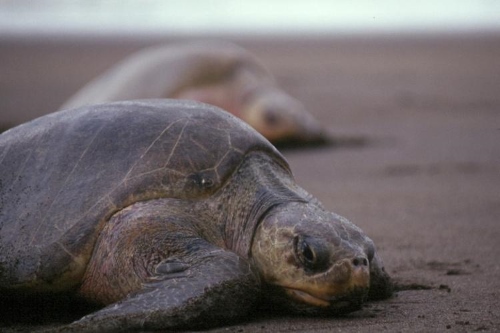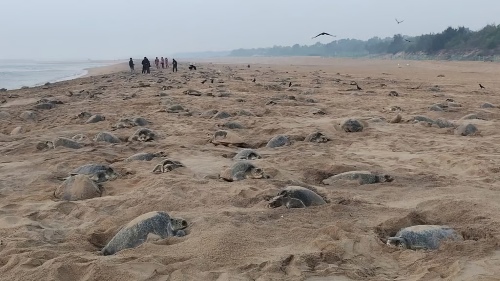Olive Ridley turtles (Lepidochelys olivacea) may be small, but their contribution to ocean health is immense. From controlling jellyfish populations to enriching coastal ecosystems, these marine guardians help maintain ecological balance. However, human activities threaten their survival. Understanding their role and taking conservation measures is essential to protecting ocean biodiversity.
About the Olive Ridley Sea Turtle
The Olive Ridley sea turtle is named after its distinctive olive-green, heart-shaped shell. It is one of the second-smallest sea turtles in the world and primarily inhabits the warm waters of the Pacific, Indian, and Atlantic Oceans.
These turtles were once abundant, with an estimated population of around 10 million in the Pacific Ocean alone. However, their numbers have significantly declined due to human activities. The biggest threats to olive ridley turtles include harvesting their eggs, poaching for meat, and accidental entanglement in fishing gear.
Conservation efforts are underway to protect and restore Olive Ridley populations. Organisations and researchers use advanced tracking and monitoring techniques to study these turtles, safeguard their nesting sites, and develop strategies for long-term survival. By collaborating with global partners, implementing conservation policies, and funding research initiatives, efforts continue to ensure the protection of olive ridley sea turtles and their natural habitats.

Source:NOAA Fisheries
Why are Olive Ridley Turtles crucial for ocean health?
Olive Ridley Turtles and Their Role in Ocean Health
The Olive Ridley Turtle (Lepidochelys olivacea) is a keystone species in marine ecosystems. Their population trends and behaviours provide insights into ocean health as they interact with multiple trophic levels and play a significant role in maintaining ecological balance.
1. Regulating Marine Food Webs
A. Diet and Ecological Role
Olive Ridley turtles are omnivorous, feeding on a variety of marine organisms, including:
- Algae: Helps in maintaining marine plant populations.
- Lobsters, crabs, tunicates, and molluscs: Regulates the population of invertebrates.
- Jellyfish: Prevents uncontrolled growth, balancing marine ecosystems.
This diverse diet prevents any single species from overpopulating, ensuring a stable food chain.
Also Read| What is Seagrass? Role & Global Distribution
B. Nutrient Cycling and Beach Stabilization
- When these turtles nest, they transport nutrients from the ocean to the land, enriching coastal ecosystems.
- Their nesting activity aerates the sand, promoting vegetation growth that stabilises beaches and prevents erosion.
2. Maintaining Coastal and Seagrass Ecosystems
A. Promoting Seagrass Bed Health
- Olive Ridleys feed on seagrass, preventing excessive growth and promoting healthy, younger shoots.
- This benefits herbivorous fish and invertebrates that rely on seagrass meadows.
- Seagrass beds serve as carbon sinks, playing a role in climate change mitigation.
B. Enhancing Beach and Dune Stability
- When female turtles dig nests on beaches, they aerate and mix the sand, improving its quality for dune vegetation.
- The nutrients from unhatched eggs and eggshells enrich coastal habitats, supporting plant growth and dune stabilisation.
- Strong dunes act as a natural barrier against coastal erosion and storm surges.
3. Olive Ridley Hatchlings as a Prey Source
- A large percentage of hatchlings do not survive to adulthood, but their presence sustains many predators, including:
- Birds (seagulls, eagles)
- Crabs (ghost crabs)
- Fish (sharks, large fish species)
- The loss of Olive Ridley populations could disrupt these predator-prey dynamics, affecting species higher up in the food chain.
4. Climate Change and Carbon Sequestration
- Seagrass beds, maintained by turtle grazing, act as significant carbon sinks, absorbing up to 35 times more carbon than rainforests per unit area.
- By sustaining seagrass health, Olive Ridley indirectly contributes to reducing carbon dioxide levels in the atmosphere.
5. Bioindicators of Ocean Health
- Olive Ridley Turtles are highly sensitive to environmental changes, such as:
- Marine pollution (plastics, oil spills, heavy metals)
- Climate change (rising sea levels, temperature shifts affecting sex ratios in hatchlings)
- Overfishing (incidental bycatch in fishing nets)
- A decline in their populations signals larger ecosystem disturbances.
What are the threats to Olive Ridley Turtles?
Despite their ecological significance, Olive Ridley turtles face multiple threats due to human activities:
1. Accidental Capture (Bycatch)
- Commercial fishing gear, especially shrimp trawl nets and nearshore gill nets, often traps turtles, leading to injuries or fatalities.
2. Illegal Hunting and Egg Collection
- Turtles are hunted for their meat and skin in some regions.
- Their eggs are harvested for consumption, leading to population decline.

Source:downtoearth
3. Habitat Loss
- Coastal development due to urbanisation, tourism, and artificial lighting disrupts nesting behaviours.
- Destruction of nesting sites makes successful reproduction increasingly difficult.
4. Pollution and Marine Debris
- Turtles mistake plastic for food, leading to fatal digestive blockages.
- Contaminated waters affect food availability, impacting turtle health.
Why Conservation is Essential for Olive Ridley Turtles?
Conserving Olive Ridley turtles is critical for maintaining ocean health. Their presence ensures:
1. Biodiversity and Ecosystem Stability
- Their feeding habits regulate prey populations, supporting marine biodiversity.
- A balanced marine ecosystem helps counteract overfishing and climate change effects.
2. Turtles as Indicator Species
- Their health reflects the overall condition of marine environments.
- Declining turtle populations signal broader ecological issues affecting human communities dependent on ocean resources.
Conclusion
The conservation of Olive Ridley turtles is vital for maintaining a balanced marine ecosystem. Their protection ensures not only the well-being of a single species but also the overall health of our oceans and the sustainability of human livelihoods. By protecting these turtles, we are committing to preserving the delicate balance of life that sustains our planet.
Comments
All Comments (0)
Join the conversation